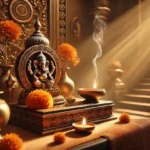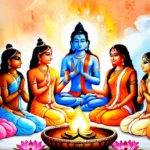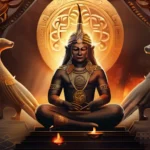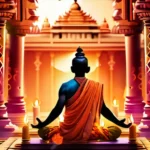Discover the pantheon of Hindu deities, their roles, and significance.
Hinduism is a rich and diverse religion with a vast pantheon of gods. In this article, we delve into the main gods worshipped in Hinduism, exploring their roles, stories, and symbolic representations.
The Trimurti: The Three Forms of God
Imagine the universe as a vast canvas, and on it, three divine figures emerge to guide its ever-evolving narrative—Brahma, Vishnu, and Shiva. These three deities make up the Trimurti, a term that translates to ‘three forms’ in Sanskrit. How do these gods shape the cosmic dance?
Brahma is often seen as the creator, the one who breathes life into the universe with his divine touch. Can you envision the first light of creation? It’s said that Brahma holds a lotus in his hand, symbolizing purity and the origin of all things. But what drives this grand architect to create?
Then there is Vishnu, the preserver. Think of him as the guardian who ensures balance and order. He keeps the universe ticking like a well-oiled machine, preventing chaos from overwhelming the cosmos. Could you imagine the weight of such responsibility? How does Vishnu manage to maintain equilibrium while countless stories unfold across the vast tapestry of time?
Lastly, we have Shiva, the destroyer. Often seen as the dynamic force that brings about change and renewal. He embodies the cycle of life, death, and rebirth. In his role, he both ends and begins anew. Can you grasp the paradoxical nature of this cosmic dancer? How does Shiva manage to orchestrate destruction with such elegance?
Together, these three deities form a symphony of creation, preservation, and transformation. Each plays a vital part in maintaining the cosmic order, yet their roles are not static. They interact and influence each other, creating a complex web of relationships that define the Hindu understanding of the divine.
The Devas: The Celestial Beings
Delve into the world of the Devas, the celestial beings who inhabit the heavens and play pivotal roles in Hindu mythology. These divine entities are often seen as servants of Vishnu and Shiva, but their significance extends far beyond their service to the cosmic triad.
Imagine the Devas as a grand ensemble, each with unique attributes and responsibilities. Just like the stars in the night sky, they shine brightly, offering guidance and protection to mortals below. The Rigveda, one of the oldest scriptures in Hinduism, mentions numerous Devatas who are personifications of natural forces and abstract concepts.
Take, for example, Surya, the god of the sun. He is more than just a radiant light; he symbolizes life-giving energy and vitality. Can you imagine the world without sunlight? It’s as if Surya’s absence would plunge us into eternal darkness. Then there’s Indra, the king of gods, who wields thunderbolts and controls rain. His power is like a tempest, capable of both destruction and renewal.
The Devas also embody various virtues and moral principles. For instance, Agni, the god of fire, represents purity and truth. He is often invoked in rituals for his cleansing powers. And who can forget Vayu, the wind god? His presence is felt everywhere, much like the breath that sustains all life.
These celestial beings are not just mythical figures; they are integral to the fabric of Hindu cosmology. They reflect the complexity and richness of human experience, mirroring our own struggles and triumphs in their narratives. So, when you pray or perform rituals, think about these Devas as the interconnected threads that weave together the tapestry of life.
The Matrikas: The Divine Mothers
Who are the main gods in Hinduism? A comprehensive guide brings us to the fascinating realm of the Matrikas, the divine mothers who embody various aspects of nature and protect humanity. Imagine a group of powerful women, each holding a unique attribute that symbolizes different forces of life—this is what the Matrikas represent.
These deities are often depicted as fierce warriors or nurturing mothers, with their names echoing through the tales of ancient India. Each Matrika has a distinct role, from providing protection to bestowing knowledge. Are they like the elements of nature personified? Do they embody the wisdom and strength found in the maternal instinct?
The primary Matrikas are Virginia, Dhumavati, Saraswati, Gauri, Nakshatrani, Kushmanda, and Bhuvaneshwari. Each name holds a profound meaning, from the knowledge-giving Saraswati to the fierce protector Gauri. These divine mothers are often seen as manifestations of Durga or Kali, making their roles in mythology and worship intertwined.
In Hindu symbolism, the Matrikas are like a tapestry, each thread representing a different aspect of life and nature. They protect humanity from various dangers and bestow blessings for prosperity and wisdom. Through their stories, we learn about the balance between strength and nurturing, power and compassion—qualities that are essential in both personal and communal life.
By exploring these divine mothers, we uncover the rich tapestry of Hindu mythology, where every deity has a purpose and a place. The Matrikas remind us of the interconnectedness of all living beings, urging us to honor the feminine aspects of divinity as much as the masculine ones. Who knew that the stories of these divine mothers could hold such deep philosophical insights?
The Avatars of Vishnu: Incarnations of God
Imagine Vishnu, the preserver god, as a seasoned conductor orchestrating the symphony of life. In Hindu mythology, Vishnu is believed to have taken on ten distinct avatars, each representing a different facet of his divine purpose. These avatars are like the different instruments in an orchestra, each contributing uniquely to the harmonious performance of existence.
How many times do you wonder about the nature of these avatars? Who was Rama, the noble king who fought against the demon Ravana? Wasn’t he a symbol of dharma and righteousness, embodying the essence of human goodness in his battles for justice?
- Matsya : The fish avatar, which warned Manu about the great flood, is like the first note that warns of impending changes.
- Krishna: As a playful yet profound figure who guided and inspired Arjuna in the Bhagavad Gita, he’s akin to the complex melody that challenges our souls.
- Lord Kalki, the avatar yet to come, is like the final note of an unfinished symphony, hinting at the ultimate resolution of cosmic conflicts.
Each avatar tells a story of resilience and transformation. They are like chapters in a grand narrative, each one adding depth and meaning to the tapestry of Hindu belief. These avatars serve as a guide for humanity, showing us how to navigate through life’s challenges with grace and wisdom.
How can we relate these stories to our own lives? Are we not all seeking ways to find balance and harmony amidst chaos? Vishnu’s avatars remind us that every individual has the potential to be a hero in their own right, capable of facing and overcoming adversity through devotion and dharma. By understanding these avatars, we can draw strength and inspiration from them as they reflect different aspects of human experience and divine guidance.
Shakti: The Divine Feminine Energy
Imagine the universe as a vast ocean, endlessly deep and mysterious. Within this ocean lies Shakti, the divine feminine energy that both cradles life and shapes destiny. Who is Shakti? She is not just a deity but the essence of creation itself. Just like the sun’s rays give light to the world, Shakti brings forth all forms in existence.
Shakti embodies the creative force, personified through various forms such as Durga, Kali, and Parvati. Each form represents different facets of her power—Durga as the fierce warrior, Kali as the embodiment of time and change, and Parvati as the nurturing mother. Is it not fascinating how these multifaceted aspects reflect the complex nature of energy itself?
In Hindu mythology, Shakti is often depicted alongside Shiva, the destroyer. Together, they form the cosmic dance of life and death, balance and imbalance. This partnership highlights the duality within creation: without destruction, there can be no renewal; without change, nothing moves forward. Through their union, existence finds its purpose.
The stories of Shakti’s incarnations are as rich as they are varied. In one tale, she takes on the form of Goddess Durga to protect the world from evil, showcasing her power in overcoming even the most formidable challenges. Can you imagine the strength and courage required for such a divine feat?
Shakti’s influence extends beyond the spiritual realm into daily life. She is worshipped through rituals, prayers, and festivals that celebrate her many forms and attributes. The Kali Puja, for instance, commemorates Kali’s victory over darkness, symbolizing the eternal struggle between light and shadow in human existence.
Understanding Shakti is to grasp the core of Hindu belief—energy, power, and transformation. In a world where change is constant, she serves as a reminder that even the most tumultuous times hold within them the potential for renewal and growth. As we navigate our own lives, perhaps it’s in recognizing and honoring this divine feminine energy that we can find strength, resilience, and a deeper connection to the universe.
Ganesha: The Elephant-Headed God
Ganesha: The elephant-headed god, known as the remover of obstacles, stands tall in the pantheon of Hindu deities. But who is this enigmatic figure? Have you ever wondered why Ganesha has an elephant’s head and what makes him so revered?
Imagine a being with a human body and an elephant’s head—this unique combination symbolizes wisdom and strength. Ganesha, often depicted holding a sweet-laden modak in his hand or riding on a mouse, is more than just a mythological figure; he represents profound symbolism.
Ganesha’s role as the parvataraja, the lord of obstacles, is not merely about physical challenges. He serves as the remover of intellectual and spiritual barriers too. Do you ever face obstacles in your life that seem insurmountable? Ganesha teaches us to approach these with patience and wisdom.
In Hindu mythology, Ganesha’s birth story offers a profound lesson. Born from Parvati’s own self when she created him to guard her while bathing, Ganesha is the embodiment of knowledge and intelligence. But his encounter with Shiva, who beheaded him in ignorance, only to restore life upon discovering the truth, teaches us about the importance of understanding and forgiveness.
As you contemplate on Ganesha, think about how he can help navigate your path through life’s complexities. Whether it’s a new business venture or personal growth, invoking Ganesha means seeking wisdom and success with obstacles removed.
The elephant-headed god is more than just a deity; he is a guide for us all to overcome the challenges of our lives. How will you integrate this wise and powerful figure into your own spiritual journey?
Conclusion
 By understanding the main gods in Hinduism, you gain insights into the beliefs, values, and cultural heritage of this ancient religion.
By understanding the main gods in Hinduism, you gain insights into the beliefs, values, and cultural heritage of this ancient religion.











